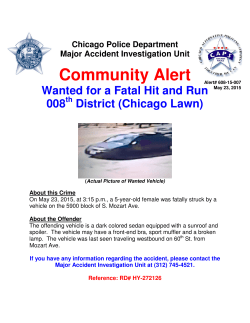
Unit 6 Test - CHHS Drivers Ed
Basic Maneuvers in a Low-Risk Environment Unit 6 Test Page 1 Select the best answer and place the appropriate letter (A, B, C, or D) on the line provided. ____1. If you must turn your car around on a narrow street and most of the traffic is coming toward you, the best type of turnabout would be: A. 3-point or Y turn. B. 2-point turnabout using a road on the right. C. Intersectional U-turn D. 2-point turnabout using a road on the left. ____2. When turning left from a two-way street, which lane should you be in? A. The right lane. B. The lane closest to the center line. C. The lane nearest to the curb. D. Any lane, if there is no other traffic present. ____3. When parking on the right shoulder of a hill where there is no curb you should: A. Point the front wheels toward the center of the road. B. Have the rear wheels closer to the shoulder. C. Turn the front wheels so they point to the side of the road. D. Place the front wheels parallel to the edge of the pavement. ____4. When two vehicles arrive at an uncontrolled intersection from different streets: A. Driver on the right shall yield to the vehicle on the left. B. Driver on the left shall yield to the vehicle on the right. C. Both vehicles must stop. D. Neither vehicle must stop. ____5. Before changing lanes, the most important thing you should do is: A. Signal to communicate with others. B. Make sure the area and travel path are open. C. Change speed to slow vehicles behind. D. Look in the rearview mirror for vehicles close to you. Basic Maneuvers in a Low-Risk Environment Unit 6 Test Page 2 ____6. What is the most important step in turning the car around? A. Careful check of traffic in all directions. B. Signal. C. Shift to the proper gear. D. Select the lane of traffic in which to turn. ____7. When deciding whether to pass a vehicle ahead of you, the most important factor to consider is: A. The size of the vehicle ahead. B. The size of a vehicle behind. C. The space and time needed to pass. D. The speed of the vehicle ahead. ____8. When preparing to make a lane change, what else should you do besides use a lane change signal device? A. Make a mirror blind area check to the left or right rear. B. Slow down a little and check the rear. C. Show a hand signal and wave everyone back. D. Change your lane position. ____9. You are able to check the mirror blind areas by: A. Glancing ahead left and right. B. Using the side-view mirror to check the rear. C. Using both the inside and the outside mirrors and a head check. D. Using the inside mirror to check behind. ____10. When braking hard, the weight of the vehicle noticeably shifts: A. To the rear of the vehicle. B. To the front of the vehicle. C. To the left of the vehicle. D. To the right of the vehicle.
© Copyright 2025













